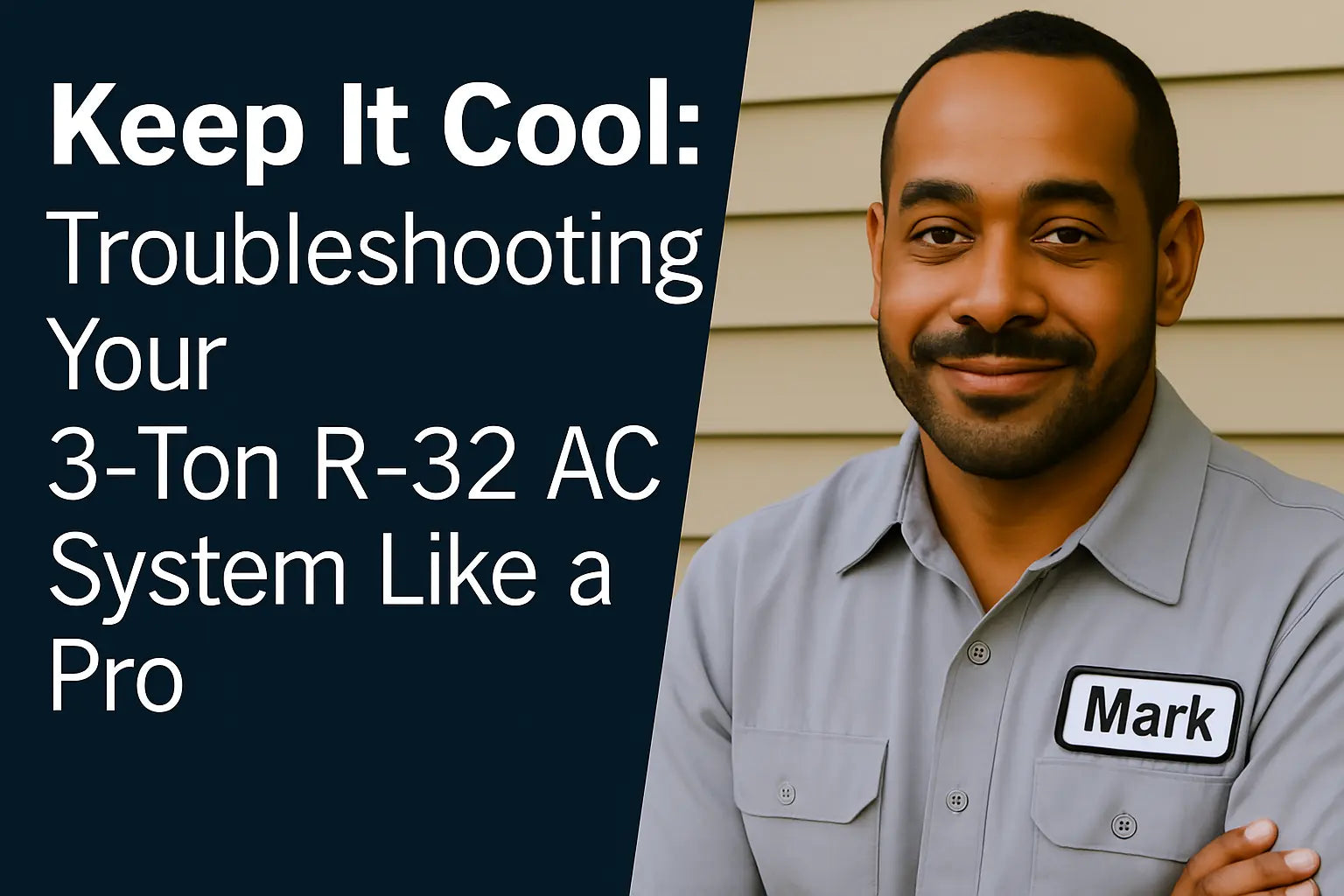🔥Mark’s No-Nonsense Guide to Staying Cool and Comfy
Hey, Mark here. So, your 3-ton R‑32 air conditioner isn’t quite living up to its chill promises. Maybe it’s leaking refrigerant, not cooling like it used to, or the pressure gauges are bouncing all over the place. Whatever the case, don’t panic. HVAC systems are complex, but most problems have a root cause you can track down — and fix — with the right approach.
R‑32 is a newer, more efficient refrigerant that’s also mildly flammable, so troubleshooting requires some extra care and respect. But once you know what signs to look for and how to interpret them, you’ll be able to keep your system humming smoothly or know when it’s time to call in the pros.
This guide will break down common issues you’ll face with a 3-ton R‑32 AC, how to diagnose leaks, no-cool conditions, and pressure fluctuations — all while keeping safety top of mind. I’ll weave in links to trusted resources and practical tips so you can confidently troubleshoot and maintain your system. Let’s get started! 🧰❄️
🕵️Diagnosing Refrigerant Leaks: How to Spot the Silent Culprit
Refrigerant leaks are one of the sneakiest causes of AC failure. They cause the system to lose cooling power gradually, damage components, and can be dangerous if left unchecked.
Signs of a refrigerant leak:
-
Poor cooling performance even after filter and coil cleaning
-
Hissing or bubbling noises near line sets or fittings
-
Frost or ice buildup on the outdoor unit or refrigerant lines
-
Oil stains or residue near fittings, a telltale sign since refrigerant oil escapes with leaks
How to detect leaks safely on an R‑32 system:
R‑32’s A2L classification means leaks carry a mild flammability risk, so use an electronic leak detector rated specifically for A2L refrigerants.
Do not use traditional soap bubbles or open flame tests. Instead, check manufacturers like Fieldpiece or Testo for A2L-compliant leak detection tools.
If you suspect a leak, immediately shut off the system and call a certified technician to handle recovery and repairs. The EPA’s Section 608 regulations require proper refrigerant recovery and handling.
❄️ No-Cool Troubleshooting: Why Is Your 3-Ton AC Not Cooling?
When your AC just won’t cool, it could be many things beyond low refrigerant.
Common causes to check:
-
Dirty air filters or clogged evaporator coils restricting airflow
-
Thermostat misconfiguration or wiring issues
-
Electrical problems like blown fuses, tripped breakers, or faulty contactors
-
Compressor failure or capacitor issues
-
Refrigerant undercharge or overcharge
Start simple: Replace or clean filters, check thermostat settings, reset breakers. If that doesn’t fix it, it’s time to dig deeper.
Using a multimeter, check compressor and capacitor electrical readings. Capacitors often fail in R‑32 systems due to higher efficiency demands.
📉 Understanding Pressure Fluctuations: Gauges Tell the Tale
Your AC’s high and low side pressure readings are your window into system health. Here’s a quick primer:
-
Normal low side suction pressure for a 3-ton R‑32 system runs between 60-75 psi (varies by temp)
-
High side discharge pressure usually sits between 200-300 psi depending on ambient conditions
Causes of abnormal pressures:
-
Low suction pressure can mean low refrigerant charge or blocked airflow
-
High discharge pressure can indicate dirty condenser coils, restricted airflow, or overcharge
-
Rapid pressure fluctuations can signal failing TXVs or expansion valves, or compressor issues
Use a high-quality gauge set compatible with R‑32 (such as those from Robinair) to measure and log readings under steady-state operation.
🔧 Step-By-Step: How to Troubleshoot Your 3-Ton R‑32 AC
-
Check airflow: Dirty filters, closed registers, or blocked ducts? Clean or clear as needed.
-
Inspect electricals: Test breakers, fuses, contactors, and capacitor health with a multimeter.
-
Check refrigerant charge: Using gauges, confirm pressure readings align with manufacturer specs.
-
Look for leaks: Use an A2L-compatible leak detector to scan all fittings and lines.
-
Monitor compressor operation: Listen for humming, clicking, or unusual noises indicating wear or failure.
-
Evaluate thermostat and controls: Make sure wiring is correct and programming fits your usage.
🧹 Maintenance Habits That Help Avoid Troubleshooting Nightmares
A stitch in time saves nine. Keeping your system clean and checked regularly avoids many common issues.
-
Change or clean filters every 1-3 months
-
Clean outdoor condenser coils seasonally
-
Schedule annual professional maintenance including electrical and refrigerant checks
-
Trim vegetation around outdoor unit for airflow
-
Watch energy usage for sudden spikes that hint at problems
🔚 Mark’s Final Words: Stay Sharp, Stay Safe, Stay Cool
Troubleshooting a 3-ton R‑32 AC system is definitely doable if you approach it methodically and respect the unique aspects of R‑32 refrigerant. Safety first — always use the right tools and protective gear, and when in doubt, call a pro.
If your system is new and you’re looking to get the best reliability and support, check out The Furnace Outlet’s 3-ton R‑32 residential AC collection. They stock units engineered for modern efficiency, matched components, and come with solid warranties.
Curious about R-32 refrigerant for this system? Visit my guide: Don’t Panic, It’s R‑32.
Don’t let leaks, no-cool situations, or weird pressure swings ruin your summer. Use this guide, keep your system tuned, and enjoy steady, efficient cooling year after year.
Stay sharp and keep cool, my friends. Catch you on the next one. 😎🧰
— Mark OUT!







